This article offers an exploration and comparison of our semi-automatic vs. robotic mixed palletizing solutions with integrated pallet wrapping.
In today’s fast-paced and ever-evolving industrial landscape, optimizing palletizing processes is crucial to maintain efficiency and competitiveness. While NūMove developed a range of mixed palletizing solutions, two of our systems are often compared: semi-automatic vs. robotic mixed palletizers with integrated pallet wrapping. As one is the fully automated version of the other, these two mixed palletizing solutions look similar but differ significantly!
The development of a semi-automatic version prior to the robotic one was part of NūMove’s strategic vision, as previously mentioned. Now that both solutions are available on the market, what factors would lead an end-user to choose a semi-automatic solution over a robotic mixed palletizer, or vice versa? What are the key features, advantages, and limitations of each approach? Let’s find out!
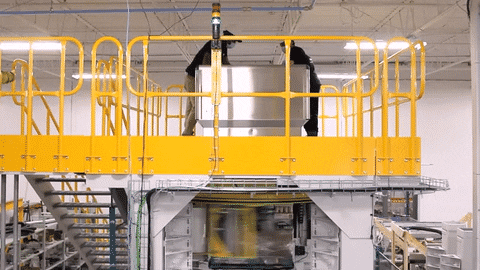
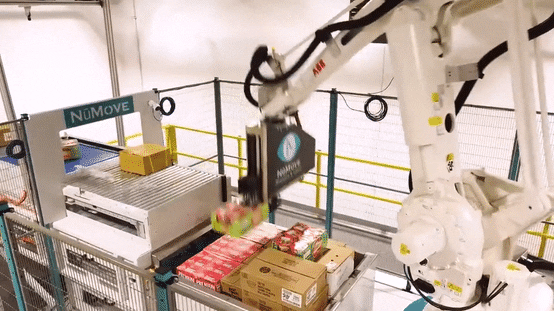
Exploration of the Semi-Automatic & Robotic Versions
Before comparing the semi-automatic and robotic approaches, let’s first define each type of application. Below are drawings to help you visualize the two solutions. The green arrows show the movement of the empty pallets, the blue arrows the path of the completed pallets, and the purple arrows where the products are fed to the palletizer.
As you can see, the structural base is quite similar, except one has a robot on the mezzanine, while the other welcomes an ergonomic space for operators. Another notable distinction lies in the product infeed. as the robotic version necessitates equipment to orient, when required, and align the products before palletization. In each solution, the pallet is lowered into a pit to ensure the load stability during the palletizing process. The integrated ring wrapper takes over to secure the load.
Below is a summary of the features of both technologies.
Semi-Automatic Mixed Load Palletizer
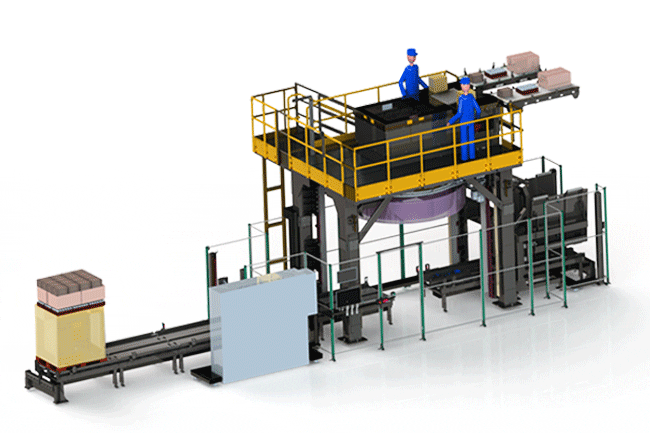
As you might expect, semi-automatic palletizing strikes a balance between manual labor and automation.
- Pallet Handling Performed Automatically: While no robots are involved, industrial equipment automates part of the process. Pallet handling tasks are automated, improving efficiency.
- Ergonomic Operator Involvement: The design of the workspace enables operators to palletize products on the pallet in an ergonomically manner, reducing strain.
- Cycle Time: To avoid lost time when a completed pallet is being wrapped, a strip plate extends into the pit so operators can continue palletizing.
- Product Infeed: Products can arrive at the palletizing station either in a random order or in a predetermined sequence, in which case a screen guides operators on where to place each product on the pallet.
Robotic Mixed Load Palletizer
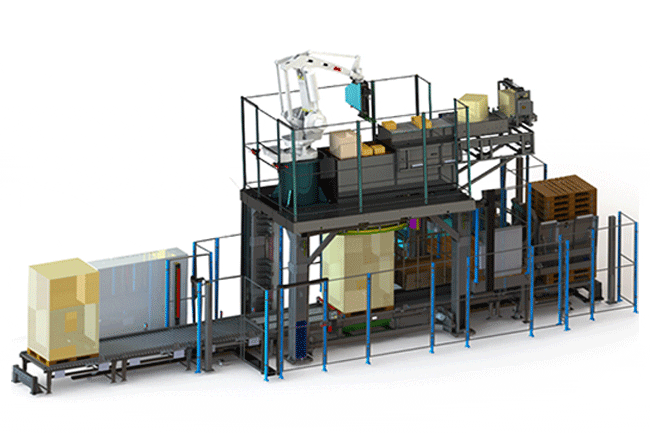
Robotized palletizing fully embraces automation as a solution to labor challenges and to ensure production stability.
- No Human Involvement: The process is entirely automated, eliminating the need for manual labor.
- Cycle Time: A vision-guided product orientor adjusts the orientation of incoming products upstream, when required, before they are picked. This enables the robot to focus solely on picking and placing products on the pallet, without having to adjust their orientation, thereby reducing cycle time. Also, a staged empty pallet is fed at the palletizing position once a completed load clears the pit, maximizing robot’s usage.
- Product Infeed & Load Optimization: An advanced software indicates the adequate product feeding sequence, and optimizes product placement on the pallet based on various criteria, such as stability, density, crushability, aisle-readiness, etc.
Comparing Mixed Palletizing Solutions: Semi-Automatic vs. Robotic Approaches
You should now have a better understanding of our semi-automatic and robotic solutions for mixed palletizing with integrated stretch wrapping. Let’s take a closer look at how these two approaches compare. Our goal isn’t to determine which solution is better. Instead, we aim to provide a clear overview of the advantages and limitations of each. This way, you can make an informed decision based on your specific needs and operational reality.
| SEMI-AUTOMATIC MIXED PALLETIZER | ROBOTIC MIXED PALLETIZER |
|---|---|
| Lower Initial Investment: Initial investment costs are lower compared to fully robotized systems. | Higher Initial Investment: The upfront costs for robotized systems are higher. |
| Higher Operating Costs: Ongoing operating costs is higher due to labor involvement. | Lower Operating Costs: Lower operating costs due to full automation. |
| Operator-Dependent Efficiency: Efficiency can vary based on the operator’s performance and skill. Also, operators are prone to fatigue and injury. Unlike robots, they have limited endurance for prolonged repetitive tasks and extended periods of handling heavy products. | No Human Involvement: The process is entirely automated, eliminating the need for manual labor. Stability of Production: A robot does not get tired and provide a stable result. Although robots have a payload limit, they are capable of repeatedly lifting heavy products. Flexibility of Production: The robotic version can be switched into manual mode if required. |
| Flexibility with Frequent Product Changes: Manual palletizing offers greater adaptability for frequent products changes or addition. | Adding a New Product Requires Intervention: Data on new products must be entered into the software before the robot can perform the palletization. |
| Variable Speed: Speed can vary depending on the operators and their level of fatigue and productivity. | Steady Speed: The rate of a robotized solution is constant. |
| Handling Random Case Arrivals: Semi-automatic systems can handle products arriving in random order. No sequencing equipment required. Alternative Sequence Arrangement: Alternatively, products can arrive in a predetermined sequence with a screen guiding operators on where to place them on the pallet. This will enhance pallet load optimization. | Maximal Efficiency when Combined with an Upstream Product Sequencing System: A case AS/RS or a similar system for sequencing products ensures optimal cycle time by supplying the products in an order that maximizes load efficiency. Load Planning Software: An advanced software optimizes feeding sequence and product placement on the pallets. |
| Large Variety of Products: Operators are capable of palletizing various packaging types and product dimensions. | Product Types: There are limitations on product dimensions and packaging type due to the features of the robot tool. |
| Footprint: Compact footprint including an empty pallet dispenser and an outfeed conveyor. | Footprint: Same footprint as the semi-automatic; however, installing a robot on the mezzanine requires additional ceiling height. |
| Maintenance: No special maintenance required compared to any other industrial equipment. | Maintenance: Although the robot itself requires minimal maintenance, the robotic version incorporates additional equipment, which increases the likelihood of maintenance needs (robot tool, infeed product conveyors). |
In summary, both semi-automatic and robotic mixed palletizing solutions share the same structural framework but differ regarding the product handling. Each approach has its advantages and limitations, necessitating distinct upstream processes to achieve optimal performance.
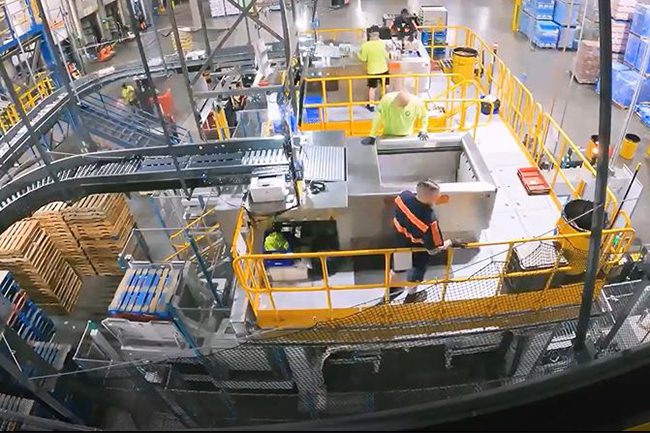
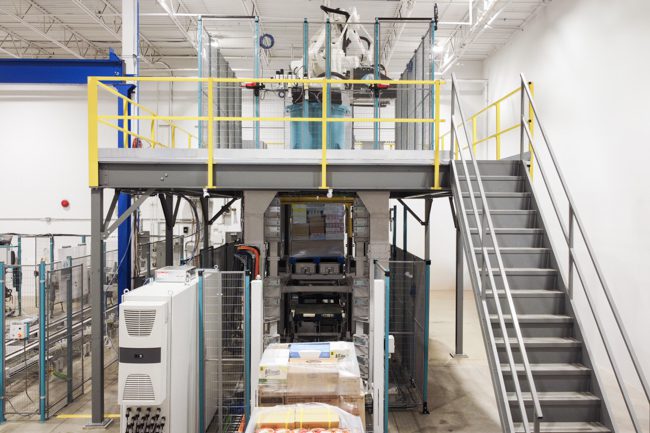
Key Considerations for Selecting a Robotic or Semi-Automated Mixed Palletizer
The decision to invest in industrial automation is often influenced by a combination of interconnected factors. While the choice is rarely straightforward, here’s a summary of the key elements that typically guide a customer’s decision at the early stages of the process:
- Labor Challenges: A customer seeking to invest in automation as a solution to labor shortages will likely be directed toward a robotic palletizing system over a semi-automated version.
- Budget: Budget considerations can significantly influence the decision. While the initial cost of a semi-automated system is generally lower, its operating costs are higher due to the ongoing need for manual labor. It is therefore advisable to consider the total cost of ownership when selecting the technology.
- Production Efficiency: If the customer’s primary goal is to optimize throughput and ensure production stability, we strongly recommend a robotic solution.
- Product Characteristics: The semi-automatic version can accept a wider variety of product packages and dimensions compared to the robotic solution. In both cases, however, it is important to ensure that the conveyor system upstream of the palletizer can accommodate these products.
- Upstream Equipment: In order to fully benefit from the capabilities of the robotic system, it is necessary to have an automated storage and sequencing system upstream. While not required for the semi-automatic solution, an upstream case AS/RS could improve performance.
To conclude, we hope you now have a clearer understanding of the benefits and limitations of each approach to mixed palletizing. If you need more information about your palletizing needs, don’t hesitate to contact NūMove’s automation and robotics experts. We’re always happy to help!
